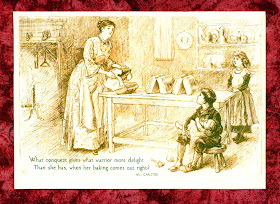Pretzels, Lords and Ladies
Lady is an ancient word of Old England. It comes from hlaefdige, which meant, literally, “bread kneader”. Hlaf meaning bread, is where we get the word loaf.
With this in mind, the Lady-of-the-House decided to exercise her ladyship. Snow was on the roof and all around. It blocked the front door. Indoors computers hummed.
But in one corner of the house dough was rising in a little blue bowl. It rose twice.
Then the Lady-of-the-House made her announcement. “It’s time to make the pretzels,” she said in her nicest voice, wishing to make it a family affair. Therefore, she put together a little speech to rally the help of the Man-of-the-House and son. “In this computer age it is good to do something three dimensional,” she reasoned. Her men folk agreed at last. The cameraman even rolled and twisted his piece of dough into a pretzel - in between shots.
Both lords and ladies are words (or titles) connected with bread. Lord comes from two Old English words, hlaf, bread, and weard, which became ward or guardian. A hlafweard was a loaf-ward or “one who guards the bread.”
Using her regular wholegrain dough recipe she then followed Pennsylvania Dutch directions for soft pretzels.
Once formed, several pretzels at a time are simmered in a solution of water and baking soda for two minutes.
Drained on a towel they are then placed on a buttered cookie sheet and given a sprinkle of coarse Celtic salt.
They are baked until golden brown.
Do you know the amazing story of the pretzel? While we are on the subject of word origins, pretzel comes from the Latin word pretiola, meaning small reward.
The legend tells of a young Italian monk who, it seems, was blessed with a good imagination and a heart for children. As early as the year 610 AD the monk noticed some leftover bread dough and was struck with an idea. He twisted small dough pieces into a shape that represented a child’s arms folded prayer. (Christians in that day would pray with their arms folded across their chest.) He used these biscuits as a treat or pretiola for children who learned their lessons and prayers. (It was also a way to feed the hungry.) The three empty holes in the biscuits helped teach the Holy Trinity. As pretiola gained in popularity it spread across the Alps into Germany where it became known as the pretzel.
Post Script
The 19th century line-drawing at the start of the post adorns a homemade card sent by a pen-friend who is in every way a lady (and kneader of bread). Baking multiple loaves for her family each week is one of her most satisfying labors of love. It is a creative and practical way she has chosen to live out her Mother Culture.
May the ideas on this post, in some way, be uplifting to you.
Karen Andreola












We have been making our bread for months now.
ReplyDeleteIt is satisfying and so good to eat.
I love the pictures! So very pretty, and affirming in our duties as wives, mothers and care-takers of our domestic domiciles.
ReplyDeleteWe made homemade pretzels for lunch today. How funny it was to see your post with your own homemade pretzels! :0)
Have a great day!
~Karen in Ohio
I think pretzel making needs to be a near-future activity with the grandkids. Fun, nutritious, and educational all wrapped up together!
ReplyDeleteHow interesting-I didn't know about this word derivations.
ReplyDeleteWe make our bread in the breadmaker but I'm keen to expand our range. Hadn't thought about pretzels-thank you for the inspiration.
Dear Karen,
ReplyDeleteEach week I so look forward to your posts. Your heart of a keeper at home always blesses me. Thank you so much for encouraging so many women to enrich their lives with "Mother Culture". I know that I have learned so much from you. Your pretzels look delicious. My married daughter made them when she was at home. I will have to try them.
Thank you so much,
Julia
Dear Karen,
ReplyDeleteI just love this blog!
Thank you so much for sharing it with us :-)
Your photos are beautiful and I want to be there to help. Is this pretzel recipe in one of your books? I would love to make them. You introduced me to Charlotte Mason just 5years ago when my son was just 2years old. Thank you. Jessica
ReplyDeleteHi Ladies,
ReplyDeleteIf you google Pennsylvania Dutch Pretzel you will find a recipe online that includes the directions for making the bread dough first. I use my regular whole grain spelt recipe (that I make in our bread machine, mostly) and find that it works well.
Fresh out of the oven the pretzels are more delicious than I can describe - if I do say so myself.
I tear mine in pieces and dip the ends in melted butter.
Sharing what impresses me about Charlotte Mason is
something I hope to continue. Thank you for encouraging me along the way.
Karen A.
Once upon a time I thought about making pretzels, but I was intimidated by boiling them. You made it look easy. Maybe I'll try it one of these days.
ReplyDeleteGod bless you friend,
Laura Lane